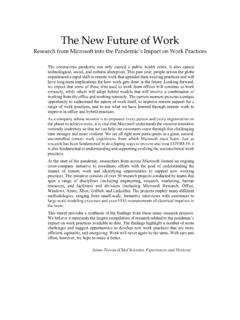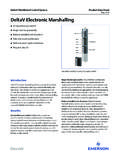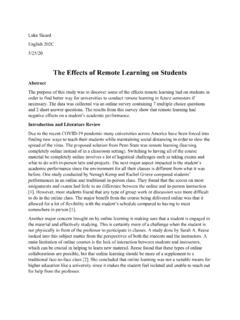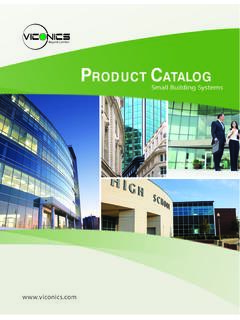Transcription of Guidance on Returning to Work - Occupational Safety and ...
1 OSHA 4045-06 2020 Guidance on Returning to WorkNOTICE: This is an OSHA Archive Document, and may no longer represent OSHA Policy. It is presented here as historical content, for research and review purposes only. For the most up-to-date information, consult Protecting Workers Safety and Health Act of 1970 To assure safe and healthful working conditions for working men and women; by authorizing enforcement of the standards developed under the Act; by assisting and encouraging the States in their efforts to assure safe and healthful working conditions; by providing for research, information, education, and training in the field of Occupational Safety and health. This Guidance is not a standard or regulation, and it creates no new legal obligations.
2 It contains recommendations as well as descriptions of mandatory Safety and health standards. The recommendations are advisory in nature, informational in content, and are intended to assist employers in providing a safe and healthful workplace. The Occupational Safety and Health Act requires employers to comply with Safety and health standards and regulations promulgated by OSHA or by a state with an OSHA-approved state plan. In addition, the Act s General Duty Clause, Section 5(a)(1), requires employers to provide their employees with a workplace free from recognized hazards likely to cause death or serious physical contained in this publication is in the public domain and may be reproduced, fully or partially, without permission. Source credit is requested but not information will be made available to sensory-impaired individuals upon request.
3 Voice phone: (202) 693-1999; teletypewriter (TTY) number: 1-877-889-5627. Guidance on Returning to Department of LaborOccupational Safety and Health AdministrationOSHA 4045-06 2020 ContentsOverview ..3 Planning for Reopening ..4 Applicable OSHA Standards and Required Protections in the Workplace ..11 Employer Frequently Asked Questions ..11 For More Information ..16 OSHA Assistance, Services, and Programs ..16 OSHA Regional Offices ..19 How to Contact OSHA ..21 Appendix A Applicable OSHA Standards and Requirements ..22 Guidance ON Returning TO WORK3 OverviewThe Occupational Safety and Health Administration (OSHA) has developed the following Guidance to assist employers and workers in safely Returning to work and reopening businesses deemed by local authorities as non-essential businesses during the evolving Coronavirus Disease 2019 (COVID-19) pandemic.
4 Employers can use this Guidance to develop policies and procedures to ensure the Safety and health of their Guidance is intended to supplement the Department of Labor and Department of Health and Human Services previously developed Guidance on Preparing Workplaces for COVID -19 and the White House s Guidelines for Opening up America Again. It focuses on the need for employers to develop and implement strategies for basic hygiene ( , hand hygiene, cleaning and disinfection), social distancing, identification and isolation of sick employees, workplace controls and flexibilities, and employee training. This Guidance is based on the application of traditional infection prevention and industrial hygiene practices to a phased approach for reopening, as the White House guidelines describe.
5 Reopening should align with the lifting of stay-at-home or shelter-in-place orders and other specific requirements of the Federal Government and state, local, tribal, and/or territorial (SLTT) governments across the United States, as well as with public health recommendations from the Centers for Disease Control and Prevention (CDC) and other federal requirements or guidelines. Employers should continually monitor federal, State, territorial, tribal, and local government guidelines for updated information about ongoing community transmission and mitigation measures, as well as for evolving Guidance on disinfection and other best practices for worker protection. Where applicable, these guidelines may supplement state- or locality-specific information and re-opening requirements.
6 The CDC provides the latest information about the COVID-19 pandemic at: Safety AND HEALTH ADMINISTRATION4 OSHA provides specific information for workers and employers about the COVID-19 pandemic at: National Governors Association provides a state-by-state summary of public health criteria in reopening plans at: www. for ReopeningAll employers should monitor SLTT health department communications to understand how the communities in which their workplaces are located are progressing through the reopening phases identified in the Guidelines for Opening up America Again. The guidelines provide general principles for relaxing restrictions that were put in place to slow the spread of COVID-19. Employers should continue to consider ways to utilize workplace flexibilities, such as remote work ( , telework), and alternative business operations to provide goods ( , curbside pickup) and services to all phases of reopening, employers should implement strategies for basic hygiene ( , hand hygiene; cleaning and disinfection), social distancing, identification and isolation of sick employees, workplace controls and flexibilities, and employee training that are appropriate for the particular general, during: Phase 1: Businesses should consider making telework available, when possible and feasible with business operations.
7 For employees who return to the workplace, consider limiting the number of people in the workplace in order to maintain strict social distancing practices. Where feasible, accommodations ( , flexibilities based on individual needs) should be considered for workers at higher risk of severe illness, including elderly individuals Guidance ON Returning TO WORK5and those with serious underlying health conditions. Businesses should also consider extending special accommodations to workers with household members at higher risk of severe illness. Non-essential business travel should be limited. Phase 2: Businesses continue to make telework available where possible, but non-essential business travel can resume. Limitations on the number of people in the workplace can be eased, but continue to maintain moderate to strict social distancing practices, depending on the type of business.
8 Continue to accommodate vulnerable workers as identified above in Phase 1. Phase 3: Businesses resume unrestricted staffing of work outbreak conditions in each community will directly affect workers exposure risks to SARS-CoV-2, the virus that causes COVID-19. For all phases of reopening, employers should develop and implement policies and procedures that address preventing, monitoring for, and responding to any emergence or resurgence of COVID-19 in the workplace or community. Employers should continue these practices to the extent possible to help prevent COVID-19 from emerging or resurging in their workplace. Such a resurgence could lead to increases in infected and sick employees, the increased need for contact tracing of individuals who visited a workplace, enhanced cleaning and disinfection practices, or even a temporary closure of the on evolving conditions, employers reopening plans should address: Occupational Safety AND HEALTH ADMINISTRATION6 Guiding PrincipleExamples of How to ImplementHazard assessment, including practices to determine when, where, how, and to what sources of SARS-CoV-2 workers are likely to be exposed in the course of their job duties.
9 Assess all job tasks performed by or job categories held by employees to determine which job tasks or job categories involve Occupational exposure. This can be a desktop assessment to maintain social distancing practices. Consider, among other things, exposures from members of the public ( , customers, visitors) with whom workers interact, as well as exposures from close contact with coworkers in the workplace. Consider current outbreak conditions in the , including practices for hand hygiene, respiratory etiquette, and cleaning and disinfection. Provide soap, water, and paper towels for workers, customers, and visitors to wash their hands, and encourage frequent and proper (for at least 20 seconds) handwashing. Provide hand sanitizer with at least 60% alcohol and encourage workers to use it frequently when they cannot readily wash their hands.
10 Identify high-traf fic areas, as well as surfaces or items that are shared or frequently touched, that could become contaminated. Target them for enhanced cleaning and disinfection using EPA-registered disinfectants and adherence to CDC Guidance for controlling the spread of COVID-19. Guidance ON Returning TO WORK7 Guiding PrincipleExamples of How to ImplementSocial distancing, including practices for maximizing to the extent feasible and maintaining distance between all people, including workers, customers, and visitors. Six feet of distance is a general rule of thumb, though social distancing practices may change as changes in community transmission of SARS-CoV-2 and other criteria prompt communities to move through the reopening phases.














